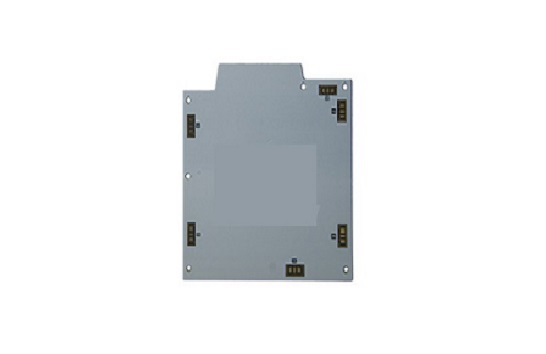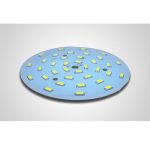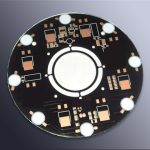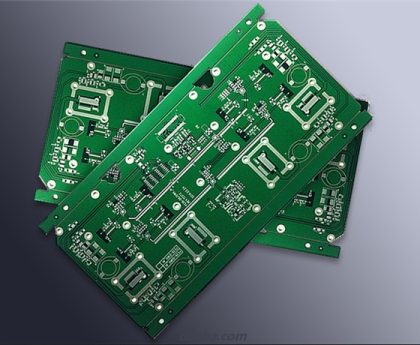Aluminum substrate is a metal based copper clad board with good heat dissipation function. Generally, a single-side board consists of a three-layer structure, namely a circuit layer (copper foil), an insulation layer, and a metal substrate. Commonly found in LED lighting products. There are two sides, one is for welding LED pins on the white side, and the other is in aluminum color. Generally, it will come into contact with the thermal conductive part after applying thermal conductive paste.
1. Structural composition of Aluminum Clad PCB
(1) Circuit layer
The circuit layer (usually made of electrolytic copper foil) is etched to form a printed circuit for the assembly and connection of devices. Compared to the traditional FR-4, with the same thickness and line width, the aluminum substrate can carry higher currents.
(2) Insulation layer
Insulation layer is the core technology of aluminum substrate, mainly playing the functions of bonding, insulation, and thermal conductivity. The aluminum substrate insulation layer is the largest thermal barrier in the power module structure. The better the thermal conductivity of the insulation layer, the more conducive it is to the diffusion of heat generated during device operation, and the more conducive it is to reducing the operating temperature of the device, thereby increasing the power load of the module, reducing volume, extending lifespan, and improving power output.
(3) Metal substrate layer
The metal used for insulating metal substrate depends on the comprehensive consideration of the thermal expansion coefficient, thermal conductivity, strength, hardness, weight, Surface states and cost of the metal substrate.
2. Working principle of Aluminum Clad PCB
The surface of power devices is mounted on the circuit layer, and the heat generated during device operation is quickly transmitted to the metal substrate through the insulation layer, which then transfers the heat out to achieve heat dissipation of the device. Compared with traditional FR-4, aluminum substrate can minimize thermal resistance, resulting in excellent thermal conductivity of the aluminum substrate; Compared with thick film ceramic circuits, its mechanical properties are extremely excellent. In addition, aluminum substrates have the following unique advantages: meeting RoHs requirements; More suitable for SMT process; Effective treatment of thermal diffusion in circuit design schemes can reduce module operating temperature, extend service life, and improve power density and reliability; Reduce the assembly of radiators and other hardware (including Thermal interface material), reduce product volume, and reduce hardware and assembly costs; Optimize the combination of power circuit and control circuit; Replace the fragile ceramic substrate to obtain better mechanical Endurance.
3. Classification of aluminum substrate
The commonly used aluminum substrate plates include 1000 series, 5000 series, and 6000 series.
(1) 1000 Series
The 1050, 1060, and 10701000 series aluminum plates, also known as pure aluminum plates, have the highest aluminum content among all series, with a purity of over 99.00%. Due to the absence of other technical elements, the production process is relatively simple and the price is relatively cheap, making it the most commonly used series in conventional industries. Currently, the majority of the products in circulation on the market are the 1050 and 1060 series. The minimum aluminum content of the 1000 series aluminum plate is determined based on the last two digits. For example, the last two digits of the 1050 series are 50. According to international brand naming principles, the aluminum content must reach 99.5% or above as a qualified product. In China’s aluminum alloy technical standard (GB/T3880-2006), it is also explicitly stipulated that the aluminum content of 1050 should reach 99.5%. The same principle applies to 1060 series aluminum plates, which must have an aluminum content of over 99.6%.
(2) 5000 Series
Representing the 5052, 5005, 5083, and 5A05 series. The 5000 series aluminum plate belongs to the commonly used alloy aluminum plate series, with magnesium as the main element and a magnesium content of 3-5%, also known as aluminum magnesium alloy. The main characteristics are low density, high tensile strength, and high elongation. The weight of aluminum magnesium alloy is lower than other series under the same area, so it is commonly used in aviation, such as aircraft fuel tanks. In addition, it is widely used in conventional industries. Its processing technology is continuous casting and rolling, belonging to the hot-rolled aluminum plate series, so it can be used for oxidation deep processing. The 5000 series aluminum plate is one of the more mature aluminum plate series in China.
(3) 6000 Series
Representative 6061 mainly contains magnesium and silicon elements, which combine the advantages of the 4000 series and 5000 series. 6061 is a cold treated aluminum forged product suitable for applications with high requirements for corrosion resistance and oxidation resistance. Good usability, excellent interface characteristics, easy coating, and good processability. The general characteristics of 6061 include excellent interface characteristics, easy coating, high strength, good usability, and strong corrosion resistance. Typical uses of 6061 aluminum include aircraft parts, camera parts, couplers, ship accessories and hardware, electronic accessories and connectors, etc.
Considering the texture, hardness, elongation, chemical properties, and price of the material itself, the 5052 alloy aluminum plate, which is commonly used in 5000 series aluminum materials, is currently commonly used as an aluminum substrate.
Opcba.com provides customers with professional and efficient PCB customization and PCB assembly services. Please contact us to inquire about your questions.





